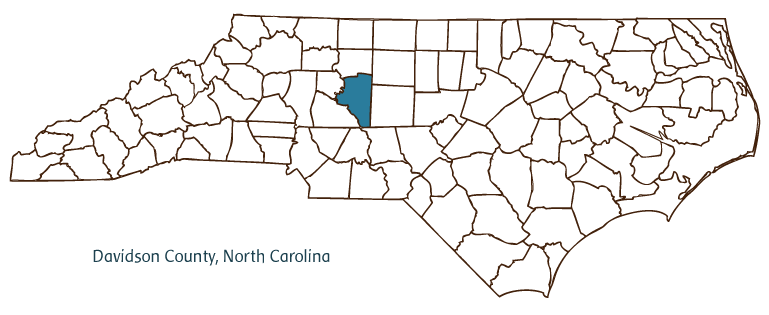Davidson County Resources
- View All:
- Biographies
- Monuments
- locations
NCpedia will be down for maintenance from 3:00-3:30 on Friday November 21st for routine maintenance. Thank you for your understanding.
Copyright Notice: This article is from the Encyclopedia of North Carolina edited by William S. Powell. Copyright © 2006 by the University of North Carolina Press. Used by permission of the publisher. For personal use and not for further distribution. Please submit permission requests for other use directly to the publisher.

Davidson County, located in the Piedmont region of central North Carolina, was formed in 1822 from Rowan County. It was named after William Lee Davidson, a Revolutionary War general killed in the Battle of Cowan's Ford on the Catawba River in 1781. The county seat, Lexington, was named by its early residents in honor of the 1775 Battle of Lexington, which marked the start of the American Revolution. Other Davidson County communities include Midway, Denton, Thomasville, and Wallburg.
Prior to its settlement by Europeans, the area along the Yadkin River that became Davidson County was inhabited primarily by Saponi Indians. The Saponi, like other native groups in the region, were confronted with major social and economic transformations as European settlers began to arrive in the North Carolina backcountry. By the time English, Scot-Irish, and German settlers arrived in significant numbers toward the middle of the eighteenth century, many Saponis had been pushed from the area by settlers and other Indian tribes or had coalesced with larger tribes. European settlers generally formed farming communities that remained small through the early nineteenth century, with German Lutheran, Moravian, and Reformed churches and communities clustered in the northern part of the county and English and Scot-Irish enclaves in the south. Gold, silver, copper, and lead mining sparked further development in the first decades of the nineteenth century. In 1855 the arrival of the North Carolina Railroad laid the foundation for growth of the county's industrial economy after the Civil War. Lexington and Thomasville, both along the railroad's route, grew rapidly and became centers for the state's textile and furniture industries, which remained robust well into the twentieth century.
In the early 2000s, Davidson County remained internationally known for its furniture production. Thomasville, home to Thomasville Furniture Industries, boasts that it is home to the world's largest chair. Proponents of western North Carolina-style barbecue (hickory-smoked pork shoulders with a tomato-laced sauce) refer to Lexington as North Carolina's barbecue capital. While lovers of eastern North Carolina barbecue strenuously dispute this claim, the Lexington Barbecue Festival is the state's largest food festival, drawing more than 100,000 people each year.
Agricultural products of Davidson County include beef cattle, hogs, chickens, tobacco, soybeans, and corn. The county has several cultural and recreational attractions and parks, including High Rock Lake, Boone's Cave Park, the Davidson County Historical Museum, Childress Vineyards, and the Richard Childress Racing Museum. The North Carolina Vietnam Veterans Memorial, located between Lexington and Thomasville, honors the state's 1,620 soldiers killed or declared missing in action during the Vietnam War. In 2004 Davidson County's population was estimated at just over 153,000.
For an annotated history of the county's formation, with the laws affecting the county, boundary lines and changes, and other origin information, visit these references in The Formation of the North Carolina Counties (Corbitt, 2000), available online at North Carolina Digital Collections (note, there may be additional items of interest for the county not listed here):
County formation history: https://digital.ncdcr.gov/Documents/Detail/the-formation-of-the-north-ca...
Index entry for the county: https://digital.ncdcr.gov/Documents/Detail/the-formation-of-the-north-ca...
References:
Bob Lasley and Sallie Holt, eds., Hometown Memories -It Always Rains When Old Folks Die and Other Davidson and Randolph County Tales: A Treasury of 20th Century Memories (2001).
Paul Baker Touart, Building the Backcountry: An Architectural History of Davidson County, North Carolina (1987).
Additional resources:
Corbitt, David Leroy. 2000. The formation of the North Carolina counties, 1663-1943. https://digital.ncdcr.gov/Documents/Detail/the-formation-of-the-north-carolina-counties-1663-1943/3692099?item=4553233 (accessed June 20, 2017).
Davidson County Government: http://www.co.davidson.nc.us/
Lexington Area Chamber of Commerce: https://www.lexingtonchamber.net/
DigitalNC, Davidson County: https://www.digitalnc.org/counties/davidson-county/
North Carolina Digital Collections (explore by place, time period, format): https://digital.ncdcr.gov
Image credits:
Rudersdorf, Amy. 2010. "NC County Maps." Government & Heritage Library, State Library of North Carolina.
Criner, Allyson C. "Davidson County." NCpedia. State Library of NC. July 2023. https://www.ncpedia.org/geography/davidson.